7 Nervous System Practices to Calm Anxiety
If anxiety is your default setting and you need tangible tools to support you in moments where it starts to spiral, keep reading (I was once there too).
When your system is in a sympathetic (fight-or-flight) state, it makes it harder to:
- Think clearly
- Sleep restfully
- Stay present
- Digest properly
- Regulate emotions
The seven, research-supported, practices I’ll walk you through in this post help you regulate before anxiety becomes overwhelming by offering micro-messages of safety that help your internal alarm system to settle. They are based in neuroscience and somatic work and have helped thousands of people shift from chaos to calm in the moments they need it most. These techniques work with you physiology, from the bottom up—addressing the body first to calm the mind—rather than trying to think your way out of anxiety (which you probably know by now just makes things worse).
Understanding Your Nervous System: A Quick Review
Before diving into specific practices, it helps to understand a bit about how your nervous system works. According to polyvagal theory, developed by Dr. Stephen Porges, our autonomic nervous system has three primary states:
- Regulation (aka Green Zone/Ventral Vagal): Here you feel safe, connected, and engaged.
- Activation (aka Yellow Zone/Sympathetic): This is your “fight or flight” response where you often feel mobilized, anxious, scared, or angry.
- Shutdown (aka Red Zone/Dorsal Vagal): Here you feel numb, exhausted, disconnected, depressed, or completely shut down.
Anxiety lives in that “yellow zone” of sympathetic activation. When we’re anxious, our bodies are in a mobilized state, preparing to fight or flee from a perceived threat. This state comes with very real physiological changes—increased heart rate, shallow breathing, muscle tension, tunnel vision, and digestive changes.
What often then follows are the spiraling thoughts, worst-case-scenario thinking, etc… This is all a natural response from the brain to messages of stress from the body. Often, the key in calming anxiety is to start with the body. To show your nervous system it’s safe, to pull on some physiological levers to help you body shift into a more regulated (parasympathetic) state.
A Crucial Note on These Practices: Taking the Edge Off & The Bigger Picture
Before we explore specific techniques, it’s important to frame their role. These practices aren’t magic wands designed to instantly take your anxiety from a boiling 10 down to a serene 2. Instead, think of them as supporters that help you take the edge off in moments of distress, I call this reactive regulation. Their primary aim is to dial down the intensity just enough – perhaps from that 10 to a 7 or 8 – so you can regain a bit more space. This space allows your thinking brain to come back online, enabling you to more effectively choose how to think or respond to your situation, rather than being completely overwhelmed by physiological alarm.
It’s also true that for lasting change, we often need to do deeper work (proactive regulation) to explore and address the root causes and triggers that repeatedly activate our nervous systems. Without this, we can find ourselves in an endless loop of managing anxiety symptoms. However, in those critical moments when anxiety peaks, having tools that work directly with your physiology to invite in more regulation can be incredibly supportive and provide immediate relief.
The Power of Tool Layering: Meeting Your System Where It Is
A core principle in working effectively with your nervous system is “tool layering.” This means starting by meeting your nervous system exactly where it is, especially when anxiety is high. If your system is highly activated (in that ‘yellow zone’), trying to force it into deep relaxation with a very gentle practice might feel jarring or even increase agitation. Instead, we first want to acknowledge and match that intensity with an appropriate tool. From there, we can gently guide the system towards greater calm by thoughtfully ‘layering’ or sequencing different types of practices as the activation subsides. This approach works with your body’s natural responses, rather than fighting against them, making the journey to regulation smoother and more sustainable.
Again, we want these practice to work with the very same body systems that shift when activated. Things like your visual system, breath, circulation, and vagal tone.
With this context, let’s explore seven practices:
5 Nervous System Regulation Practices to Soothe Anxiety
1. Physiological Sigh:
The physiological sigh is a breathing pattern that directly signals to your nervous system that you’re safe. This technique is backed by research from Stanford neuroscientist Dr. Andrew Huberman and offers one of the quickest ways to dial down your body’s stress response.
How to practice:
- Take two quick inhales through your nose (sniff, sniff)
- Follow with one long, slow exhale through your mouth
- Repeat 2-3 times when you notice anxiety building
Why it works: The double inhale followed by the slow exhale helps reset carbon dioxide levels in your lungs and activates your parasympathetic (calming) nervous system. It’s a simple but powerful technique that can be done anywhere, anytime, without anyone noticing.
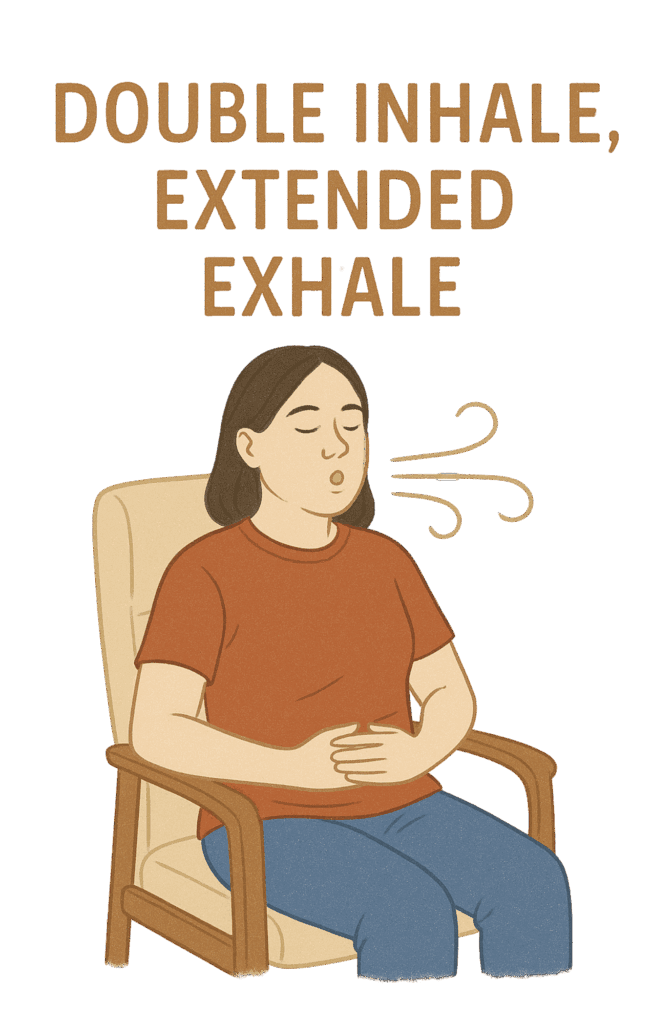
2. Visual Orienting:
When we’re anxious, our visual field tends to narrow (tunnel vision), which signals danger to our nervous system. Actively engaging your peripheral vision and consciously orienting to your surroundings sends safety signals to your brain.

How to practice:
- While keeping your head still, slowly scan your environment with your eyes
- Notice details in your peripheral vision
- Name a few things you can see, hear, and feel
- As you do this, notice any shifts in your body’s tension level
Why it works: This practice draws from somatic experiencing therapy and helps anchor you in the present moment while activating regions of your brain responsible for safety and social engagement.
3. Somatic Movement:
Movement helps discharge the excess energy that builds up in your body during anxiety. As explained in polyvagal theory, our yellow zone of activation is a mobilized state—your body literally needs to move. Working with this natural impulse, rather than fighting it, can help release tension and promote regulation.
How to practice:
- Gentle shaking: Starting with your hands, then arms, shoulders, and finally your whole body, gently shake to release tension
- Shoulder rolls: Slowly roll your shoulders forward and backward
- Swaying: Stand with feet hip-width apart and gently sway side to side
- Spontaneous movement: Allow your body to move in whatever way feels natural
Why it works: The key is to follow your body’s impulses rather than forcing structured movement. Even small, subtle movements at your desk can help discharge nervous energy. When it comes to shaking or swaying specifically: shaking is a natural way animals release stress and trauma (tremor response), it helps discharge built-up adrenaline and nervous energy from the sympathetic nervous system, releasing physical tension. Swaying is a repetitive, rhythmic, self-soothing movement that can activate the parasympathetic nervous system, promoting calm and a sense of safety, similar to how rocking calms an infant.
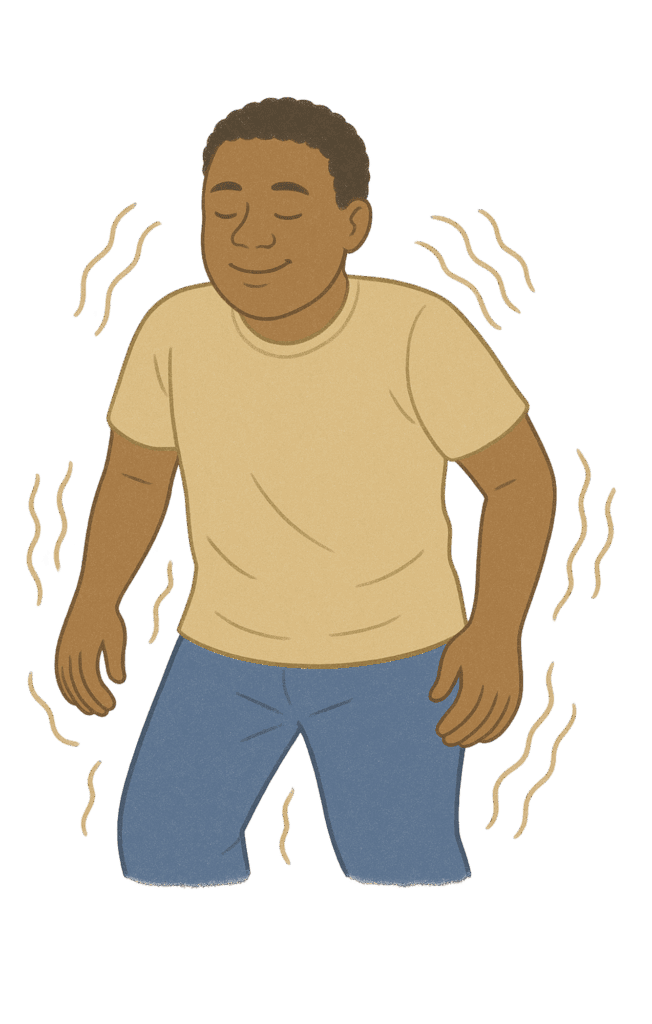
4. Extended Exhales:
This breathing technique emphasizes the calming part of your breath cycle to actively soothe your nervous system.

How to practice:
- Repeat for several breath cycles (e.g., 5-10 breaths or for 1-2 minutes).
- Sit or lie down comfortably.
- Inhale gently through your nose for a comfortable count (e.g., a count of 3 or 4).
- Exhale slowly and fully through your mouth or nose for a longer count (e.g., a count of 5, 6, or even 8), as if you’re slowly deflating a balloon.
- Pause briefly after the exhale if comfortable.
Why it works: Extending your exhale significantly activates the parasympathetic nervous system via the vagus nerve. This slows down your heart rate, reduces blood pressure, and signals to your brain that you are safe, counteracting the fight-or-flight response associated with anxiety.
5. Vagus Nerve Stimulation:
The vagus nerve is the main pathway of your parasympathetic nervous system—your body’s relaxation response. Stimulating this nerve helps shift you from anxiety into a more regulated state.
How to practice:
- Cold exposure: Splash cold water on your face or place an ice pack on your upper chest
- Humming or singing: The vibration stimulates the vagus nerve
- Neck massage: Gently massage the sides of your neck and behind your ears
- Deep belly laughing: Even forced laughter has been shown to increase vagal tone
Why it works: Regular stimulation of your vagus nerve not only helps in moments of anxiety but can also build your long-term capacity for stress resilience.
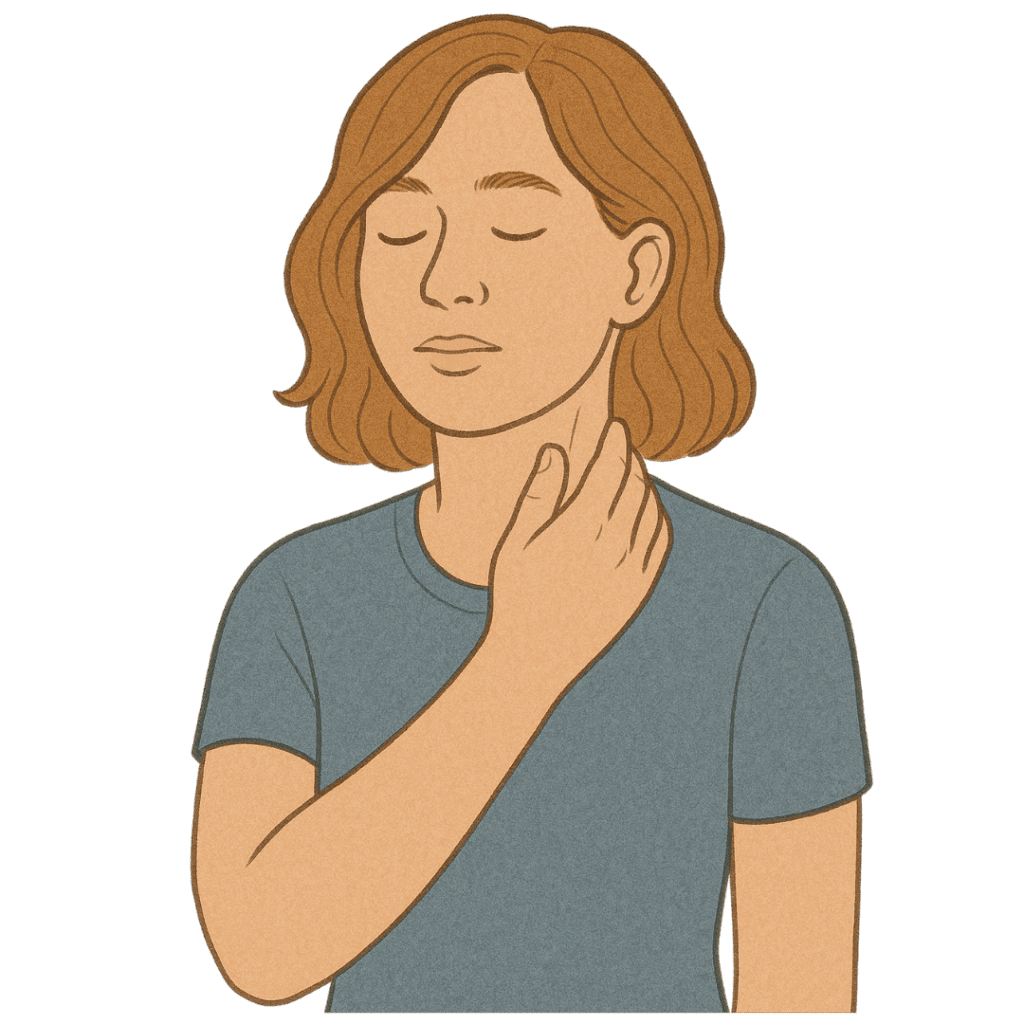
6. Legs Up the Wall:
This gentle, restorative yoga pose has a profound impact on your nervous system. By elevating your legs, you activate the baroreceptors (pressure sensors) in your neck and chest, which signal your brain to slow your heart rate and breathing.
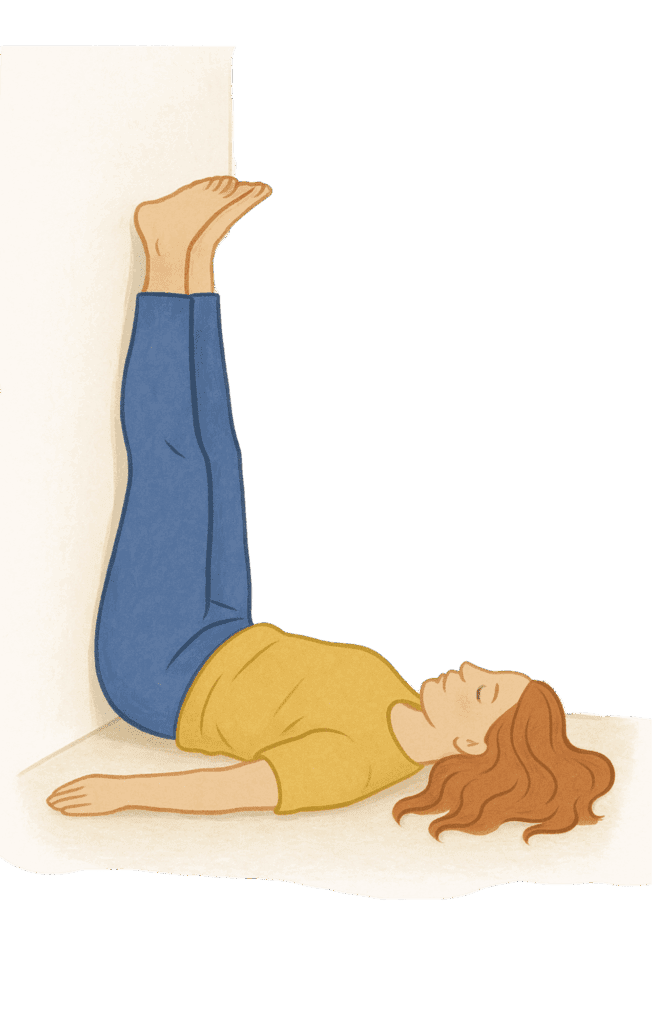
How to practice:
- Sit with one hip against a wall
- Swing your legs up the wall as you lie back
- Allow your arms to rest by your sides, palms up
- Close your eyes and breathe normally for 5-10 minutes
Why it works: This pose is particularly helpful for anxiety that feels overwhelming or when you feel your mind racing before bed. The physical position naturally induces a state of calm.
7. Progressive Muscle Relaxation (Tense & Release):
This practice involves systematically tensing and then releasing different muscle groups to promote physical relaxation and awareness.
How to practice:
- Find a comfortable position.
- Start with your hands: inhale and tense them into fists for 3-5 seconds, noticing the tension.
- Exhale, releasing the tension completely, noticing the feeling of relaxation.
- Move to other muscle groups (e.g., arms, shoulders, face, chest, legs, feet), systematically tensing and releasing each one. You can also do a quicker version by tensing larger areas or even your whole body (carefully) and then releasing.
Why it works: This practice helps you become more aware of the contrast between tension and relaxation in your body. By consciously tensing and then releasing muscles, you can actively let go of physical stress that often accompanies anxiety. It also helps to discharge physical energy and can ground you in your body.
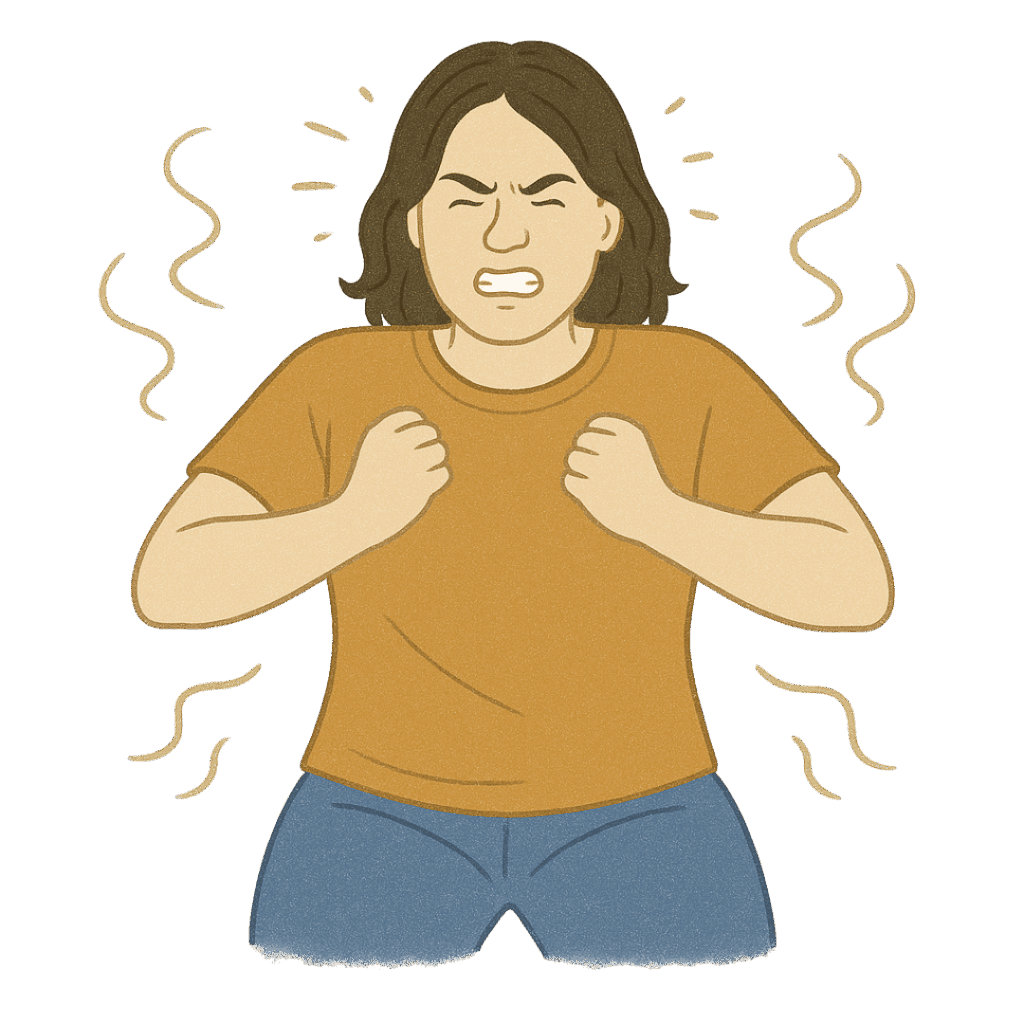
Tool Layering in Action: An Example Sequence for Anxiety
Now that you have a set of practices, let’s revisit the concept of tool layering with a practical example. Remember, the key is to match the intensity of your anxiety with the type of tool you choose first, then gradually shift to more calming practices as your system begins to settle.
- If you’re experiencing high anxiety (e.g., feeling panicky, restless, heart racing):
- Initial Response (meet the intensity & mobilization): Start with active Somatic Movement like shaking or walking to discharge that mobilized fight-or-flight energy. Alternatively, try Vagus Nerve Stimulation via cold exposure (splashing cold water on your face). The goal is to give the intense energy an outlet or provide a strong sensory input to interrupt the panic.
- Next Layer (begin to downshift): Follow with a few rounds of the Physiological Sigh to quickly engage the parasympathetic nervous system.
- If anxiety is more moderate (e.g., feeling worried, uneasy, tense but not full panic):
- Initial Response: Engage in Orienting to Your Environment to ground yourself in the present and signal safety. You might also try gentler Somatic Movement like swaying or shoulder rolls.
- Next Layer: Incorporate other forms of Vagus Nerve Stimulation like humming or gentle neck massage. The Physiological Sigh can also be used here.
- When anxiety is mild or you’re working on maintaining calm (e.g., feeling slightly unsettled or proactively regulating):
- Practices: This is a great time for restorative practices like Legs Up the Wall. Gentle, mindful breathing (without forcing) or continued, soft Orienting can also be beneficial.
This are just some example sequences. The most important thing is to listen to your body’s response and adjust accordingly. Experiment to find what layering strategies work best for your unique nervous system.
The Power of Practice
The effectiveness of these techniques grows with consistent practice. Just as you wouldn’t expect to get physically fit from a single workout, nervous system regulation requires ongoing attention and care.
Also know that these are not one-size-fits-all. Some may feel more accessible than others depending on your unique nervous system and current state, this is something we help our clients explore inside RESTORE, our 1:1 coaching program and The Regulated Living Membership. And remember that regulation isn’t about never feeling anxious—it’s about having the tools to work with anxiety when it arises and building a nervous system that returns to balance more readily.
Final Thoughts
Anxiety doesn’t have to control your life. By understanding how your nervous system works enough to work with it is key and these practices offer a starting point for your regulation journey. As you become more familiar with your own nervous system’s patterns and preferences, you’ll discover which approaches work best for you in different situations.
Want to learn more?
Here’s some other resources to support this conversation:
- Healing Through the Vagus Nerve Book: Chapter 5 & 6 offer more reactive tools, tool layer suggestions, and more!
- Regulate & Rewire Podcast, specificially:
- 3 part anxiety series:
- Episode 10: How to Recover from Being Triggered
- Episode 13: Guided Regulation Practice for Anxiety
- Episode 25: Creating a Regulation Game Plan
- Episode 71: Feel Like You’re Always in a Rush? Hit Play
- Episode 99: Reactive Regulation: Learn In or Change Course?
- Episode 105: Reactive Regulation: Your In-The-Moment Nervous System Toolkit (Part 5: B2B Series)
- Episode 106: Reactive Regulation in Real Life (Part 6: B2B Series)
- Looking for more personalized support with nervous system regulation? Our Regulated Living Membership and 1:1 Restore Program offer guided resources and individualized coaching to help you build a regulation practice that’s tailored to your unique needs.
This article is for informational purposes only and is not a substitute for professional medical advice, diagnosis, or treatment. Always seek the advice of your physician or qualified mental health provider with any questions you may have regarding a medical condition.
Leave a Reply Cancel reply
A mental health newsletter that feels like a deep breath: simple, grounding, and here to remind you that healing is possible.
The Weekly Rewire
Navigate
Regulated Living provides neuroscience-backed mental health coaching to help you regulate your nervous system and reclaim your life from anxiety and depression.
Heal
Learn
Paragraph